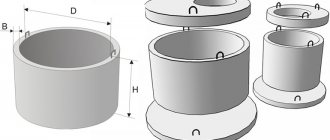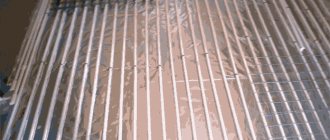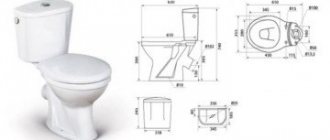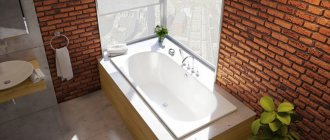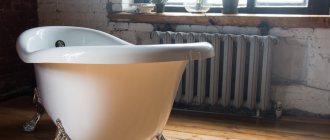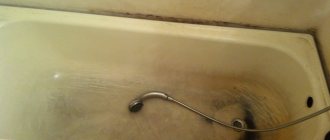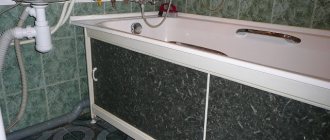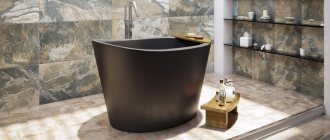Advice from specialized experts will help you choose an acrylic bathtub. In addition to the general characteristics, special criteria inherent in acrylic are taken into account.
Key indicators for any bowls:
- Manufacturer company.
- Appearance
- Configuration, installation type, dimensions.
- Ergonomics.
- Life time.
- Price.
Specific data:
- Brand, material manufacturer.
- Technical details.
- Frame design.
- Equipment, additional options.
No. 1. Acrylic baths: advantages and disadvantages
We'll talk about production technology a little later. First, let's find out the main advantages of acrylic bathtubs:
- light weight and easy to transport;
- a huge variety of shapes and sizes . Traditional rectangular and oval, round and corner, with lighting or hydromassage – acrylic bathtubs are available in a wide range, so you can choose the right product for a bathroom of any size. Moreover, at the production stage, the acrylic mass can be painted in the desired shade - we get a crazy assortment;
- acrylic retains heat , so the water in such a bathtub will cool slower than in cast iron or steel, by about 10C per 30 minutes;
- good sound insulation properties . If you were annoyed by the noise of water filling a steel bathtub, now your nervous system can rest - acrylic dampens noise well;
- smooth, pleasant surface that is easy to clean;
- excellent antibacterial properties. Mold will not appear on such a bathtub;
- sufficient strength, ease of restoration.
Now about the disadvantages of acrylic bathtubs :
- the cost is slightly higher than for cast iron and steel bathtubs;
- acrylic is inferior in strength to cast iron, so when installing it, you can’t do it with legs alone - you need a frame that will additionally support the bathtub and take on the load from the water and the bathing person;
- falling heavy objects can damage the surface of the bathtub;
- It is not recommended to use abrasive detergents - scratches may remain on the bathtub;
- Acrylic is not very resistant to high heat. We are talking about a temperature of +1600C, but under normal operating conditions this drawback will not manifest itself.
The durability of an acrylic bathtub depends on many factors. A high-quality, albeit not the most expensive, sample can withstand active use for 10-12 years, and with proper care - even more.
It is difficult to say which bathtub is better, acrylic or cast iron, since much depends on the budget and the requirements put forward. If you don’t need sophisticated forms, and the budget for purchasing plumbing fixtures is small, then you can opt for the cast-iron option, but today such bathtubs are still being massively replaced by more modern acrylic ones.
What nuances should you consider when choosing: expert advice
Quality
With a fairly large selection, it is not always possible to quickly navigate. Here are some recommendations, following which you can buy a truly high-quality product.
- For a good bathtub, the side cut should always include only two layers - an acrylic sheet and reinforcement. Its service life is more than 10 years. If the product has only one layer, it means that the bathtub is made entirely of inexpensive plastic. Bathtubs made of three layers - plastic, acrylic and reinforcement - are also low quality products. They contain a small amount of acrylic, essentially acrylic-coated plastic that has a short lifespan.
The side cut will show how many layers the bathtub design includes. If, after looking at the side cut in bright light, you notice some kind of third layer, this indicates that this is a cheap plastic bathtub that will soon lose color and become covered with cracks.
- Choose bathtubs with the thickest walls possible. If you see a bathtub with thin walls, but at a high price, do not take it. This is the case when the price does not correspond to the quality. The thickness can be checked by ear: knock on the wall, the sound should be dull. Another sign: high-quality products do not transmit light. Please also take into account that the thickness of the acrylic layer on the side cut is maximum; on the sides of the product it is much less.
Be sure to take a bright flashlight to the store. When choosing a bathtub, use it to determine whether there are any visible spots in the body that indicate the poor quality of the material.
- Check with the seller what reinforcing material was used in production. If it's polyurethane - great, it doesn't conduct heat well and is non-toxic and odorless . However, today many manufacturers use fiberglass and ether resins - they have an unpleasant chemical smell. This “underside” of the bathtub is rough to the touch and can leave splinters. Fiberglass is also less durable than polyurethane and can release harmful substances into the air.
Unfortunately, inexpensive bathtubs with various options such as hydromassage are reinforced, as a rule, with fiberglass, because it makes it easy to embed nozzles and other necessary elements into the walls of the bathtub.
- A high quality and durable bathtub will not contain too many kinks.
Check that there are no places in the structure where water can stagnate.
- High-quality bathtubs should have a perfectly smooth and shiny surface.. In low-quality ones, it is porous and slightly rough.
Shine a flashlight along the bottom and walls inside the bathtub: with its help you will notice the slightest irregularities that will indicate the poor quality of the product.
- It is also important to evaluate the quality of the acrylic bathtub frame. The simplest frame is a welded or prefabricated rectangular metal frame under the bottom that can withstand water pressure and the weight of a person. The side walls are not reinforced, but this is not required for a high-quality product with a regular rectangular shape. A complex frame is usually included in a set of non-standard-shaped products; it has additional elements that strengthen the walls around the entire perimeter.
But if a fairly inexpensive bathtub has a complicated frame, this may be a signal that the manufacturer is hiding its low quality in this way: without an extensive frame, such a bathtub simply cannot withstand the weight and becomes deformed.
The frames of acrylic bathtubs depend on the shape of the product, but any frame should not be too complex, this may indicate low rigidity of the bathtub itself
Comfort
What shape of bath is better to take?
Acrylic baths can be of the following forms:
- rectangular;
- round or oval;
- corner;
- asymmetrical.
A rectangular bathtub fits well into a standard small-sized room; it is often installed from wall to wall. It has a minimal frame and one side panel. Hydromassage and similar options on such models, if they exist, are rare, because additional equipment for a small bathtub with access from only one side is extremely inconvenient to install and subsequently maintain or repair.
The corner bath is available in two variations - right and left. The free side can be convex or concave, straight or rounded. These bathtubs are suitable for medium-sized and large rooms.
Round and oval products take up a lot of space, significantly reducing space, but they can create a luxurious atmosphere in a spacious bathroom. Often these models have hydromassage.
An asymmetrical bathtub is an ideal solution if you need to fit a bathtub into a complex room, but, as a rule, it also requires a significant amount of space. Such products are also often equipped with hydromassage equipment.
Additional options
If you choose an acrylic bathtub, pay attention to the availability of pleasant options; perhaps one of them is missing for you to be completely happy. But be prepared for the fact that they will significantly increase the cost of the bath, and such a product will require additional maintenance on your part. The most common functions:
- Hydromassage or Jacuzzi - once upon a time, bathtubs with this function were considered a luxury; now they are available to many consumers. It is necessary to take into account the number and location of nozzles, this affects the quality of the massage. It should be done from the back and sides. Some models provide foot hydromassage. It is worth considering that such baths are larger in size than baths without a Jacuzzi.
- Aeromassage differs from hydromassage only in technique. The nozzles create air jets, so in addition to pleasure, you will also observe air bubbles. Children will love this massage.
- Chromotherapy is a type of light treatment. This function allows you to carry out water procedures in beautiful lighting effects, which promotes relaxation.
- The water heater is designed to maintain a suitable water temperature.
- Sensors for measuring temperature and water levels, stands, headrests - all these additions are designed to increase the level of comfort.
No. 2. Technology and material for making an acrylic bathtub
The technology for producing acrylic bathtubs is quite simple. The acrylic sheet is heated to a temperature when the material acquires good ductility and fluidity. Then it is placed under a press, which forms the shape of the bathtub. The reverse side of the bath is reinforced with a composite; polyester resins with fiberglass, or polyurethane, are often used. After this, all the necessary holes are drilled.
Acrylic bathtubs today refer to two different types of products , which are made from different materials:
- bathtubs made of cast acrylic are the best option. Such products are created on the basis polymethyl methacrylate. The compound is poured into sealed molds and undergoes polymerization in steam ovens. Such bathtubs are very strong, wear-resistant and durable, lasting at least 10-12 years. Additionally, the acrylic bowl receives a reinforcing base;
- co-extruded acrylic bathtubs, or two-layer plastic, ABS/PMMA. ABS is acrylonetrile butadiene styrene, an elastic plastic that forms the base of the bathtub and makes up about 90% of its mass. PMMA is the already familiar polymethyl methacrylate, also known as acrylic, of which there is only 5-10%. Such baths also receive a reinforcing base. They are produced by simultaneous extrusion and combination of melts of two substances. ABS plastic has a porous structure, so it can absorb moisture to a small extent. If such a bathtub is used frequently, the base will quickly collapse. The thin acrylic layer also wears off quickly, so the durability of such bathtubs is low.
At first glance, it is obvious which bath is better to choose. Of course, the one made from cast acrylic, even if it costs more. This is true in cases where you select plumbing fixtures for an apartment or house where you live permanently. For a country house with seasonal living, you can safely take a bathtub made of ABS/PMMA - the savings will be noticeable, and wear and tear under variable loads will not be catastrophic.
Conscientious manufacturers and sellers will always honestly say what material a particular bathtub is made of. But what to do if doubts creep in and you want to make sure that you are not being deceived? Everything is simple - just count how many layers the bathtub is made of , and to do this, look at the edge on the side. A bathtub made of cast acrylic will have only two layers: acrylic and a reinforcing base. A cheaper option made from co-extruded acrylic is distinguished by the presence of three layers: acrylic, plastic and base.
What's better
As you understand, the most expensive containers are made using injection molding technology. They have a long service life and are easy to care for. Some manufacturers give them a 10-year warranty (subject to installation and maintenance recommendations). This is an excellent choice, but not everyone can afford such baths. A good option is bowls made of sheet acrylic. They are quite reliable and have a relatively low price. Both options are good because if scratches or chips form, they can be repaired. Scratches are polished, and chips are filled with repair compound.
Composite bathtubs are the cheapest segment, but they cannot be repaired. Chips and scratches will remain forever. There is one more point: when using cheap acrylic, the surface becomes porous and dirt gets clogged into the pores. It is very difficult to remove it, because strong agents cannot be used. So it is difficult to maintain such bathrooms. Even if the acrylic layer does not crack, they quickly lose their appearance.
Chips may appear, but they can be repaired
If you want to choose a good quality acrylic bathtub, take the time to go to exhibition centers to see and touch samples from different manufacturers. When inspecting, pay attention to the thickness of the walls. On the cut in the area of the sides you can evaluate how well the container is reinforced, and the thickness of the acrylic is also visible here. When inspecting, estimate how much the declared thickness of the acrylic layer corresponds to reality.
If you have chosen several brands, inquire about certificates before purchasing. Serious companies provide acrylic paper and also certify their products according to European and international standards. The presence of such papers is one of the signs of the seriousness of the campaign, and their absence is a reason to wonder whether you are about to buy a fake.
No. 3. How thick should an acrylic bathtub be?
We will not surprise anyone if we say that the thickness of an acrylic bathtub and its durability are directly proportional . You can evaluate the thickness of a particular sample right in the store by looking at the end of the bathtub rim. Thickness ranges from 2 to 6.5 mm:
- products with a thickness of 2-3 mm are the cheapest, but are durable for 3-4 years;
- bathtubs with a thickness of about 4 mm under constant loads can last about 7 years;
- bathtubs with a thickness of 5-6.5 mm are long-lived and can last 10-12 years.
Sometimes you can find samples about 8 mm thick . They are expensive, and it is not easy to give them complex shapes. However, it often turns out that it is not acrylic at all, but several layers of plastic.
Nice additions
Modern acrylic containers can be equipped with various additional features.
- The most common and popular is hydromassage or jacuzzi. This function is possible thanks to the nozzles built into the sides of the bathtub, through which air enters the water, forming many bubbles. The result is a very pleasant and useful procedure.
- No less useful is the chromotherapy function. This procedure is based on the effect of UV rays on the skin, which come from chrome-plated nozzles built into the walls of the container. Before purchasing an acrylic product with this option, it would be useful to inquire about what power the lamps have and whether reflectors are available.
- For people who cannot part with a laptop and TV even in the bathroom, manufacturers offer designs equipped with a shelf for a gadget or a built-in plasma panel.
Its price ultimately depends on what options are installed in the acrylic container. Such add-ons certainly cannot be cheap, and only serious ones can guarantee their high-quality and uninterrupted operation.
Choosing a high-quality acrylic bathtub is not an easy task. Therefore, before you go to the store to make a purchase, it is a good idea to arm yourself with at least a minimum set of information about this product. Read articles about plumbing, reviews from its owners, advice from masters and experts in this matter. They will help you make the right choice. Properly selected plumbing fixtures will delight their owners for many years and will become a favorite of the whole family.
No. 4. Pay attention to the reinforcing layer
If acrylic bathtubs were made without a reinforcing layer, they would not withstand heavy loads. Many people are accustomed to evaluating different bathtub samples, so to speak, from above, looking at the snow-white acrylic and analyzing the dimensions. It also doesn’t hurt to look “under the body” and look at the reinforcing layer. There are few options for its implementation:
- a layer of polyurethane , which is dark in color, has sufficient strength, is environmentally friendly and odorless. This is ideal for a bath;
- layer of a mixture of ester resins and fiberglass inferior in strength and characterized by an unpleasant odor, which manifests itself when heated to high temperatures. This reinforcement has a rough surface and sharp edges, so during installation you must be especially careful not to get hurt.
The reinforcing layer should not be thin. This can again be assessed by the end of the side. However, some cunning sellers deliberately make the sides thicker, knowing that buyers who are knowledgeable and savvy in matters of choosing an acrylic bathtub will definitely look at the ends. The rest of the bath receives a thinner layer of reinforcing layer, so it doesn’t hurt to carry out additional experiments. You can lightly press the bottom of the bathtub and its walls with your hand: normally, the material should not sag.
For another check, you will need a flashlight or laser pointer. It is necessary to lean the switched-on flashlight against the bottom of the bowl and look from the back to see if the light penetrates. You can fold your palms and look into the hole formed between them to assess as accurately as possible whether some of the rays pass through the material. A sufficient layer of acrylic and reinforcement will not allow a drop of light to pass through. Remember that the thickness of the reinforcing layer must be uniform throughout the entire bathroom.
Bath reinforcement methods
Acrylic itself is not particularly durable - this material is primarily valued for its flexibility and ductility. For proper rigidity, acrylic bathtubs are covered with a reinforcing layer. This layer is applied to the product during production and covers the bowl made of the base material.
The number of reinforcing layers varies from 1 to 5, depending on the quality of the bath. To evaluate the reinforcement, a careful look will be enough - all layers are clearly visible at the end of the product. High-quality reinforcement is applied evenly over the entire outer side of the bathtub.
You need to inspect not only the ends of the product. The thing is that manufacturers know about the rules for assessing the quality of a bathtub, so often the end sections are covered with a higher-quality layer of reinforcing fiberglass. To avoid becoming a victim of such deception, it will be enough to carefully push through the bottom and walls of the bathtub - high-quality reinforcement will prevent sagging.
In addition, you can use an additional verification method. To do this, you need to take a small flashlight, turn it on, and place it close to the bottom of the bath. Next you need to put your palms together and apply them to the bathtub on the opposite side. If the light of the lantern is clearly visible, it means that the thickness of the bottom of the bath is less than the thickness of the walls - and this indicates a lack of balance, i.e. the product is not of sufficient quality.
To summarize, three methods are used to check the bath:
- Careful examination of the end side of the product;
- Easy pressing of the walls and bottom of the bathtub;
- Checking for transmission using a flashlight or laser beam.
It is also worth understanding that all these principles apply to most stores, especially if they are not specialized. If the store is questionable, as are the products presented in it, then it is better to refuse to purchase it. Problems rarely arise with products from well-known manufacturers, but it would be better to play it safe and check everything once again.
No. 5. What should be the surface of an acrylic bathtub?
The internal surface should be smooth, glossy and free of flaws in the form of scratches, bumps or roughness. All these defects are a sign of a fake or a product of not very high quality, which is unlikely to serve you faithfully for ten years.
Experts advise checking the quality of the surface by pressing your palm against the walls of the bathtub. The palm seems to stick a little to a perfectly smooth surface (a mirror is the best example), so with good acrylic there should be approximately the same effect.
Description of material
The advantages and disadvantages of acrylic are determined by its composition and performance characteristics. The properties of the plastic determine the features of caring for the bowl and its installation on the frame.
Acrylic composition
Acrylic plastic consists of polymerized methacrylate (PMMA). Another name for this material is plexiglass, or plexiglass. During production, additives are added to acrylic monomers, which give the plastic color, opacity and bactericidal properties.
If the bathtub has a composite structure, then its bottom layer consists of acrylonitrile butadiene styrene - ABS plastic.
This material is more impact-resistant and rigid, but has high porosity and is less resistant to pathogenic microorganisms.
Physical characteristics of acrylic
Physical and mechanical characteristics of acrylic and ABS
| Polymer properties | PMMA | ABS |
| Density, g/cc | 1,1-1,2 | 1,02-1,08 |
| Tensile strength, MPa | 40-70 | 35-50 |
| Compression resistance, MPa | 70 | 46-80 |
| Bending strength, MPa | 140 | 50-87 |
| Hardness, HB | 170-180 | 90-150 |
| Thermal conductivity, W/(m×°C) | 0,15-0,2 | 0,12-0,17 |
| Operating temperature, °C | Up to 100 | Up to 75-80 (At 90-105 the plastic begins to soften) |
Due to low thermal conductivity, the bathtub is not cold to the touch and maintains the water temperature for a long time.
Plexiglas belongs to the group of thermoplastics. Unlike thermosets, when heated after polymerization, it does not collapse, but melts and takes on a new shape under pressure. ABS plastic is also a thermoplastic material.
Performance properties
Acrylic bathtubs have the following performance properties:
- Low porosity. The absence of small cavities in the polymer prevents moisture accumulation and mold formation. ABS plastic has a larger number of pores, so it is less resistant to water.
- High ductility and flexibility. This property manifests itself not only during the molding of the bowl, but also during its use. The PMMA layer may bend slightly under the weight of a person. To increase rigidity, acrylic is reinforced with fiberglass or ABS.
- Low impact strength. Plexiglass easily breaks when a heavy object falls, and a metal tip can pierce the wall of the bathtub. To split solid acrylic, a drop of a steel ball (0.8 kg) from a height of 15-20 cm is sufficient; to form a crack on a bowl made of ABS and PMMA, a drop of a load from 1.5-2 m is sufficient.
- Antimicrobial properties. Acrylic contains antibacterial and antifungal additives, so mold and plaque do not form in cracks and scratches. Bowls made from several types of plastic are less hygienic because if the surface is damaged, germs and moisture can enter the pores of the underlying layer.
- Increased friction coefficient. A plastic bowl is less slippery than an enamel bowl. As the product is used, the surface roughness increases.
- Sound absorption. Plastic has good noise-insulating properties, so water procedures, washing and cleaning the bathtub are practically inaudible from behind the bathroom door.
- Maintainability. Regardless of the bowl’s production technology, if it is damaged or worn, it can be restored with liquid acrylic. Baths made of solid PMMA can also be renewed by grinding.
- Instability to the action of aggressive substances. Acids, alkalis, alcohols and solvents damage the structure of polymerized methacrylate. On a light-colored bathtub, traces may remain even from household pigments - hair dye, methylene blue, etc. If the bowl is made of 2 different types of plastic, then chips may form on it from impacts and aggressive cleaning.
High-quality acrylic bathtubs can withstand weights of up to 500 kg.
Safety for the human body
Acrylic polymer is safe for humans. ABS plastic, when exposed to high heat and prolonged use, can release a toxic substance - acrylonitrile.
Toxic substances are released mainly during production, where the process temperature is more than +200°C. If the bathtub is used in accordance with the instructions, the risk of releasing harmful substances into the water is minimal.
Difficulty of care
To prevent damage to acrylic during cleaning, you must follow these rules:
- Wash the bowl with a soft sponge. Even if heavily soiled, do not use abrasive powders, metal scrapers or hard brushes for cleaning. Scratches from sharp objects should be repaired immediately with liquid acrylic, as they will trap dirt and germs.
- Do not use chlorine-containing or ammonia-based products, solvents, acids or alkalis. Active chlorine makes the polymer more porous, and other aggressive substances corrode the surface. Concentrated acids, formaldehyde, acetone, esters, alcohols and chloride hydrocarbons (dichloroethane, etc.) are dangerous for PMMA. To clean the surface, you can only use gels and sprays marked “For acrylic”. Safe folk remedies include soft toothpastes, liquid soap, diluted lemon juice, and a weak solution of soda and vinegar.
- Do not disinfect the polymer surface with boiling water or steam. At high temperatures, the walls of the bath begin to deform. To avoid cracking, water and washing solutions should be cooler than +60…+70°C.
Installation of acrylic bathtubs: is it difficult to install?
Acrylic bowls are mounted on legs, a metal frame or bricks. The load-bearing support consists of several square pipes.
How to install a bathtub on supports:
- Assemble the factory frame. Install the racks on which the sides of the bowl rest. At the bottom they are connected to the supporting structure. If the bathtub is mounted on legs, then this step is skipped.
- Turn the bowl over. Screw the frame or support strips for the legs to the bottom. To install the frame, use self-tapping screws, which are sold complete with the bathtub.
- Attach the racks (legs) to the frame or slats and adjust their height. From the side of the screen, which covers the lower part of the bath, L-shaped washers are screwed onto the legs. They create a stop for the decorative strip.
- Drill holes in the walls, install fasteners for the screen and bathtub.
- Place the sides onto the screwed plates. Adjust the height of the posts on the frame.
- Connect the drain and overflow system, check the connection for leaks. Install screen.
Advantages and disadvantages of acrylic
The advantages of acrylic for bathtubs include:
- hygiene;
- light weight;
- no rust;
- heat and sound insulation properties;
- non-slip surface;
- ease of installation and repair.
The plasticity of plastic during molding allows you to obtain a wide range of shapes and sizes of bathtubs.
The disadvantages of the material are:
- instability to high temperatures;
- difficulty in caring for the surface;
- low impact strength, prone to cracking;
- deflection under load;
- sensitivity to scratches and chips;
- flammability.
No. 6. Acrylic bathtub size
In terms of size, it’s more difficult to give advice. Everyone, when deciding which acrylic bathtub to choose, must take into account the size of the bathroom and their own requirements for the comfort of water procedures. The main thing is that the product is comfortable for all family members.
You can focus on the following ergonomic tips:
- the side of the bath should be located at a height of 65-70 cm from the floor. Adults, teenagers, and children can easily get into such a bathtub;
- the depth of the bath (the distance from the bottom of the bowl to the overflow hole) should be 50-60 cm. If the bath is shallower, the water may not cover the entire body; if it is deeper, you will have to hold your head awkwardly so as not to choke;
- the width sufficient for one person of average build is 75-80 cm, but there are a lot of wider products on sale;
- length usually ranges from 120 to 180 cm and can be even longer. The choice depends on the height of the family members and the available space in the bathroom. A bathtub 120 cm long is very inconvenient; in a bathtub 150 cm long, the knees of tall people will be bent, and a product 165-170 cm long with a headrest is perfect for people with a height of up to 180 cm.
On sale you can find simply gigantic bathtubs that can accommodate 2 or even 3 people at the same time. Such luxury costs a lot of money, and it cannot fit in every home.
Material selection
To decide which acrylic bathtub to choose, you need to consider several parameters, but the material of manufacture is worth noting first. The description of the characteristics and features of a particular product does not matter - all that is needed is to conduct a careful inspection of the bathtub.
You need to pay attention mainly to the number of layers that can be seen on the side of the product:
- Three layers
. If the bathtub is made of three layers, then it consists of a base, ABS and PMMA. - Two layers
. In this case, the bath consists of pure PMMA, complemented by a reinforced base.
Having understood the types of bathtubs and learned to distinguish them, you need to move on. The next point you need to decide is to decide which acrylic bathtub is best to choose for specific operating conditions. There are a number of nuances here that require careful consideration.
No. 7. Shape and color of acrylic bathtub
Unlike cast iron, acrylic allows you to create bathtubs of almost any shape. The most common baths are:
- rectangular is a classic that will be appropriate in almost any bathroom. Such products are quite convenient, but many may accuse them of being simple;
- oval bathtubs – also a fairly common option, it looks more interesting than rectangular bathtubs, in terms of convenience and compactness they are on par;
- round bathtubs look very impressive, they have decent dimensions, but there will be enough space for swimming. Such products will decorate the bathroom, but will be appropriate only in fairly large rooms;
- Corner baths allow you to use every square centimeter of the room to your advantage. In addition, they look very good, but due to the increased width in the corner area, some problems may arise during washing;
- asymmetrical bathtubs complex shapes will make the interior unique and emphasize your own taste. A special chic is a bathtub with a transparent glass insert. The main problem with asymmetrical bathtubs is the difficulty in finishing after installation, so when purchasing, it is better to immediately take a special panel that will act as a screen.
The choice of the shape of an acrylic bathtub entirely depends on the area of the room and everyone’s personal preferences . To some extent, the shape is also influenced by the chosen interior style.
As for the shade , glossy snow-white is a universal, win-win option. If you want to move away from this standard and choose a colored bathtub, then think carefully about how harmoniously the bowl will combine with other plumbing fixtures and the interior. Bathtubs in bluish and turquoise tones look good, giving the water a marine tint, but you need to be very careful with all the color options. The rule “measure seven times, cut once” applies here.
What about brands?
According to experts, it is recommended not to save money when purchasing an acrylic bathtub and to give preference to proven brands that can last for many years.
The market presents a large number of models of different quality levels and price categories. Manufacturers offer plumbing fixtures made of acrylic in any color of the rainbow. A win-win and universal solution is a glossy snow-white bathtub. When choosing a non-standard colored bowl, a harmonious combination with other plumbing fixtures and the interior is important.
German and Italian designs are considered expensive and high quality. These foreign manufacturers prioritize quality. There are plumbing products from the company GNT (Germany), Sunranz (Germany), Artcheram (Italy) or Novellini Elysium (Italy). Acrylic bathtubs are very durable with an average price from 55,000 to 200,000 thousand rubles.
Simplified and cheap acrylic products are produced by Turkish or Chinese companies. Of course, there is also functional plumbing from the company EAGO (Eago) from Hong Kong, but if we are talking about ordinary market models, then it is possible to purchase an acrylic bathtub at a price of 6,000 to 30,000 thousand rubles.
No. 8. Metal frame for acrylic bathtub
The bathtub, made of cast acrylic, is able to retain its shape when filled with water. A bathtub made of ABS plastic with an acrylic coating may be slightly deformed under water load. In any case, the bathtub bowl requires reinforcement with a special welded or prefabricated metal frame. After installation, the frame is hidden behind decorative overlays or tiles. Typically, manufacturers complete bathtubs with suitable screens so that everything looks harmonious, and conscientious companies make screens from the same acrylic as the bathtub itself. Some companies, trying to save money, make the screen out of plastic, and then the surface of the bowl and the lining can vary quite significantly.
The cheapest option is a welded or prefabricated structure that covers only the bottom of the bath and takes on the vertical water pressure. A more reliable and expensive frame also has side elements that will support the walls of the bathtub.
Product strength
If you are interested in how to choose a high-quality acrylic bathtub, you must take into account its strength. A quality bathtub should be able to withstand the weight of water when fully filled with virtually no deformation. Products made from molded plastic PMMA meet this requirement. ABS/PMMA baths have less strength and may deform when fully filled. High-quality products of this type will have slight deformation. If the bathtub is not of sufficient quality, then it will be noticeably deformed. Frequent deformations of plastic when using sanitary products lead to wear and reduce service life.
An acrylic bathtub, as a rule, comes complete with a frame on which it is installed. The frame is made in the form of a welded or prefabricated frame. Expert advice on choosing an acrylic bathtub necessarily requires taking into account the strength and rigidity of not only the product itself, but also its frame, as well as its design.
The frame not only supports the bathtub, but also limits its maximum deformation. The frame must have at least 4 racks attached to the top of the bathtub from the inside. At the bottom, the racks end in legs, on which the entire structure stands. The legs are usually made of rubber or other shock-absorbing material and are height adjustable. A longitudinal profile is attached to the vertical posts, which is linked with a transverse profile. It is on these crossbars that the bathtub bowl rests. This is the simplest and most common frame design.
The frame may also have additional metal elements, with the help of which the side walls of the bowl are reinforced. This eliminates their deformation and increases the overall service life of the product. However, it must be taken into account that an overly reinforced frame may indicate the low quality of the plastic itself, which has insufficient strength. A particularly clear indicator would be the presence of more than 4 vertical posts with legs.
No. 9. Additional functions of an acrylic bathtub
The main advantage of acrylic bathtubs is the ability to equip them with a lot of additional functions and turn an ordinary bathroom into a kind of spa. Typically, the following options may be present as additional features:
- jacuzzi. Everyone is accustomed to calling acrylic hydromassage bathtubs jacuzzi after the name of the Italian Jacuzzi, who is the author of this idea. The operating principle of such a bath is as follows. A special motor takes some of the water from the filled bath and returns it to the bowl through special nozzles that mix water with air. An aerated stream of water, supplied under pressure, creates a massage effect, relaxes and tones muscles, and allows a person to relax. When choosing an acrylic bathtub with hydromassage, pay attention to the quality of the nozzles - ideally they should be metal, not plastic. Also pay attention to the nature of their placement. It is advisable that the pump does not make much noise during operation. Naturally, the water pressure from the nozzles must be regulated;
- chromotherapy often combined with hydromassage, but can be used separately. This is achieved through blue LED lighting with prismatic reflectors built into the side walls of the bathroom. In theory, this effect on the skin stimulates blood circulation and has anti-inflammatory properties. It is difficult to assess the effectiveness of future chromotherapy procedures by looking at a bathtub. It all depends on the power of the backlight and its focusing;
- There are bathtubs that can be built into a smart home system via Wi-Fi, but for many these capabilities still seem like an unnecessary extravagance, and there is some truth in this.
If your goal is to buy an acrylic bathtub with hydromassage, then preference should be given only to large, trusted manufacturers, since we are talking about a rather complex system.
What additional options should I take?
Due to the auxiliary parameters, acrylic bathtubs make taking water procedures pleasant and comfortable. To increase comfort while swimming, almost all plumbing fixtures are equipped with headrests, stands or armrests.
The most popular and healthy addition is the Jacuzzi model. In addition to the usual properties characteristic of an acrylic bathtub, the jacuzzi is equipped with hydromassage, which is a relaxing and healing procedure for the human body. A similar hydromassage effect occurs when air is mixed with water jets supplied through the nozzles. By turning the nozzles the direction of the jets changes. These sprayers can be located on the sides or built into the bottom of the bowl.
Another option that children will especially enjoy is air massage. Water jets mix with directed air currents, resulting in the formation of bubbles on the surface.
There is also chromotherapy. Using this function, directional lighting colors the water jets in certain shades, which, in combination with hydromassage, helps to enhance the beneficial effect on the human body.
Modern acrylic models are equipped with elements such as game consoles or radios. The system is controlled by a hydraulic switch or control panel. Plumbing fixtures with a special shelf for a laptop or a product with an integrated panel with a plasma TV are common. The jacuzzi has Wi-Fi or a direct connection to the central smart home system. These acrylic bathtubs meet any preferences and requirements.
Types of acrylic products
The plasticity of acrylic during molding allows you to obtain bathtubs of non-standard configuration. Bowls can have not only rectangular, but also angular, oval, round and asymmetrical shapes.
Rectangular shape
Rectangular bathtubs are easy to install and use. They are installed close to the wall.
Depending on the size of the room, the bowl can rest on 2 or 3 walls.
A rectangular bathtub has the following advantages:
- it can be repaired using an acrylic liner;
- There are full-size and seated configurations;
- the sides are adjacent to the supporting walls;
- the bottom is installed on a simple frame or legs;
- you can make and design the screen yourself;
- It is comfortable to lie down in a rectangular bowl with your legs stretched out.
The disadvantage of this design is that it occupies all the free space near the wall (when supported on 3 side surfaces) or has an acute angle (when supported on 2). In addition, standard bowls do not have built-in shelves.
Corner designs
Corner baths allow you to conveniently organize your space. The recess of the bowl itself can have the shape of an oval or trapezoid with a rounded lower base. In the corner there is a seat, a shelf for bath accessories or equipment for hydromassage.
The advantages of the corner design are:
- space saving;
- possibility to choose the shape of the bowl;
- availability of additional devices and functions.
The disadvantages include:
- high price;
- the difficulty of caring for a bowl with curves and shelves;
- large volume, which increases water consumption.
Bathtubs in the form of an isosceles triangle are suitable only for large rooms. In bathrooms with an area of up to 10 square meters, it is better to install bowls with 1 short and 1 long side.
Round products
Round bathtubs are only suitable for spacious bathrooms. They often have hydro- and aeromassage installed.
The advantages of this design are spaciousness and the ability to install without additional supports.
Disadvantages include high price and cumbersomeness. The diameter of the bath for 1 person is 1.5-1.6 m, and for 2 – from 1.8 m.
Oval baths
An oval bathtub can be suitable for classic, baroque, modern and retro style.
Its advantages are:
- compactness;
- possibility of installation on legs without a screen;
- wide range of sizes.
If the bowl is installed on stands, then it can be freely moved around the room. This is convenient for cleaning and minor repairs.
The disadvantages of oval bathtubs include the lack of functional elements and higher cost than standard rectangular models.
In most cases, it is installed so that at least 15-20 cm remains from the wall.
Asymmetrical designs
Asymmetrical designs allow you to customize your bathroom design.
The most popular forms are:
- trapezoid;
- a drop;
- intersection of 2 circles;
- half of a trapezoid with a rounded outer side.
Only that part of the side on which the shelf for bath accessories is located can be asymmetrical.
TOP 5 best manufacturers of acrylic bathtubs - 2020-2021 quality rating
The rating of acrylic bathtubs allows you to study the assortment of the oldest companies pursuing long-standing traditions of sanitary ware production and young factories searching for new solutions. Both options offer the potential for many benefits.
Jacob Delafon
The French follower of the classic aristocratic style strives to rid bathrooms of bright colors and unnecessary pretentiousness. The brand has been highly positioned in the plumbing market since 1889; in Russia, products under the Jacob Delafon brand were introduced in 1994. The “trick” of Jacob Delafon plumbing is the lack of ready-made solutions. Curtains, screens, faucets, bathtubs are made in the same style. Consumers can independently select individual elements while maintaining the harmony of the design.
The acrylic bathtub Jacob Delafon Corvette 3 160×70 E60903-00 looks elegant. The design of the model successfully combines functionality and convenience. Softened corners inside the bowl make it easy to clean. The smooth angle of the backrest follows the anatomical features of the human body. Built-in headrest and two armrests increase comfort. The Corvette 3 acrylic bathtub is installed on adjustable legs provided in the package. Buying a model costs 17,000 rubles.
The corner acrylic bathtub Jacob Delafon Bain Douche 135×135 E6219-00 R captivates with its elegant design and increased operating comfort. Buyers are offered a shower space, an ergonomic backrest, and a corner seat. Bowl depth 44 cm, volume 230 l. The set includes a bowl and adjustable legs with a height of 95-140 mm. The base price of the font is 69,000 rubles.
Riho
The products of the Dutch brand are easy to identify by their characteristic names - most of the Riho acrylic bowls correspond to geographical locations: Colombia, Carolina, Miami, Livorno. The bulk of production capacity is located in central Europe. The bathtubs are equipped with accessories from the UK and assembled in factories in Holland and the Czech Republic. The quality of the materials used and the assembly method allows us to give a guarantee for a period of 10 years; obligations on the Russian market are fulfilled by official representative offices.
White acrylic Riho bathtubs will fit well into any interior. The Petit 120×70 rectangular sitting bathtub, made of high-quality 100% acrylic, will cost inexpensively. The surface of the product is protected with an antibacterial coating. The bottom is reinforced with laminated chipboard, which gives the structure increased strength and stability. Bowl depth 43 cm, volume 165 liters. The model is supplied as a separate bowl, without legs. Costs 25,598 rubles.
Riho Desire Wall Mounted BD07 deep oval acrylic bathtubs look good in luxurious interiors. The model is made from a solid cast panel and is placed against the wall of the room. Acrylic has a high degree of wear resistance and prevents the growth of microbes. Easy to clean. Product dimensions: 180x80 cm, depth 59.5 cm, capacity 230 l. The delivery set includes a bowl, legs, and overflow. The cost of the structure is 227,231 rubles.
Triton
High-quality plumbing at affordable prices from a Russian manufacturer - simple, Triton hydromassage systems. The company's products are in good demand in Russia and foreign countries. Triton designers focus on the needs of the local market. Most products are designed for medium to small bathrooms. However, owners of new buildings and private houses will be able to choose a good option. The quality of the products is ensured by a set of European brands. The product warranty period is 10 years.
The asymmetrical acrylic bathtub “Scarlet” deserves special attention. The modern, cozy, glossy design has a presentable appearance, is easy to use and maintain. Regular dishwashing preparations are sufficient. The main purpose of making a bathtub is to be sized to fit a washing machine nearby. Bath depth: 380 mm. The set includes a bowl and frame. The bottom is equipped with a corrugated massage surface, the back is wide, installation of a mixer and a front screen is allowed. The cost of the Triton “Scarlet” acrylic bathtub 167×96 is 18,000 rubles.
“Sabina” is a huge hydromassage bathtub that can accommodate three seats, hydromassage, a comfortable seat, and a bottom with a corrugated coating. Acrylic bowl depth: 44 cm, width, length 160x160 cm. Price 25,400 rubles. The set includes a font and a frame.
Villeroy & Boch
Acrylic bathtubs from the German brand Villeroy&Boch will appeal to adherents of the high-tech style - the products look great in a minimalist interior. Villeroy Bosch production lines are located in Europe and Mexico. Villeroy&Boch bathtubs are offered to customers willing to pay high prices for good quality.
The simplest, most economical solution is the acrylic bathtub Villeroy&Boch O Novo 180×80 UBA180CAS2V-01 - a rectangular, built-in design, equipped with wide sides, comfortable slopes for the back on both sides. A characteristic difference of the model is the increased depth of 50 cm. The shade is alpine white, the surface is smooth and non-slip. High-quality acrylic is warm, pleasant to the touch, warms up quickly, and retains heat for a long time. The volume of the acrylic bath is 200 l, weight is 23.5 kg. Price: 33,700 rubles.
Acrylic bathtub Villeroy&Boch Legato 190x90 is the best choice for adherents of modern style. The product is based on high-quality acrylic in a flawless white shade. Bath volume - 236 l. Legato acrylic hot tub installation - wall-mounted. Cost - 105,749 rubles.
Alpen
The Alpen company was founded at the turn of the 20th and 21st centuries, with production facilities located in Poland and Austria. The manufacturer's products are recognized by European consumers and are well positioned in the CIS market. The variety of products is represented by standard bowls, full-fledged complexes for SPA procedures: hydromassage, aroma and chromotherapy. Products may be equipped with additional lighting and additional accessories.
For square-shaped rooms, the best option would be to purchase a teardrop-shaped acrylic bathtub. The Austrian-made product is made in a modern style and meets high quality standards, confirmed by a 10-year guarantee. Product dimensions (W/H/D): 1050/470/1600 mm. Volume: 200 l. Price: 27,600 rubles.
The elegant and spacious oval bathtub Alpen Ventura 194×100 AVB0019 will also complement the modern interior.
Made from 100% Lucite acrylic sheet, the bowl is smooth and warm to the touch, does not absorb dirt, and is easy to clean. Product depth 44 cm, volume 310 l. Installation: free-standing, on legs. The recommended cost of an acrylic bowl is 53,000 rubles.
Important! Before purchasing, you should check the package contents of the product. An extended set is preferable, including a drain and overflow, a decorative screen, and a frame for installation.


